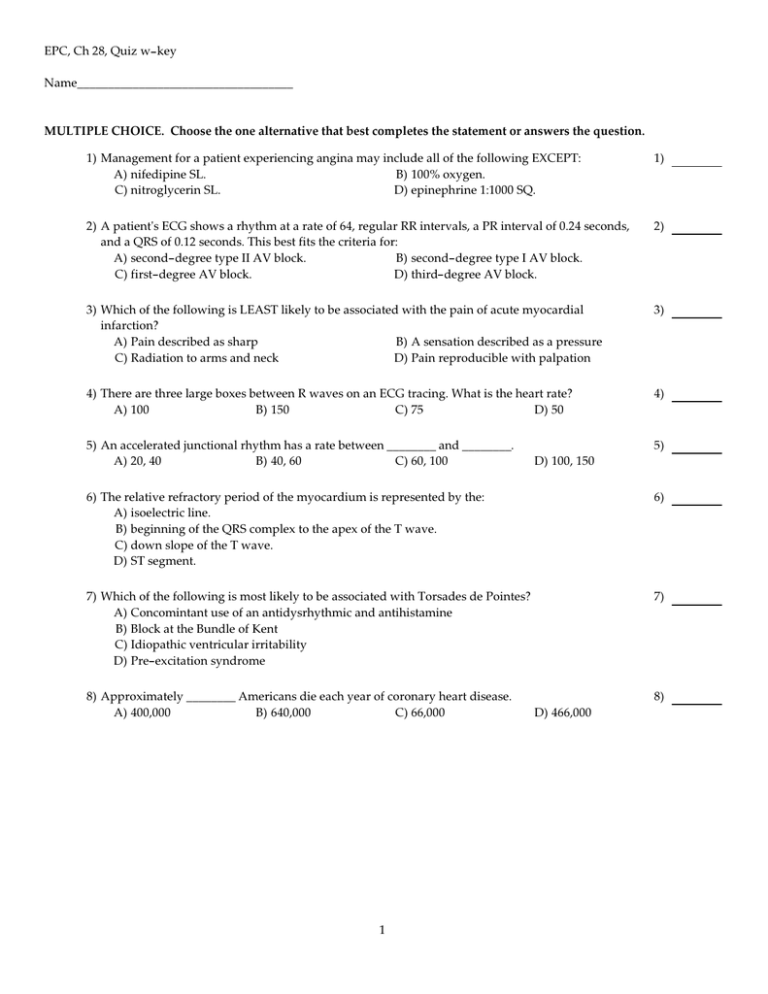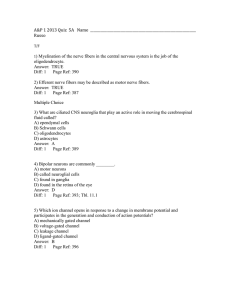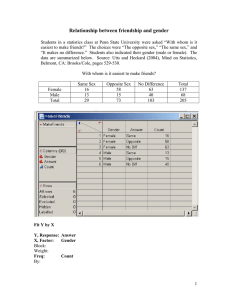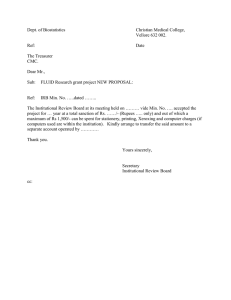EPC, Ch 28, Quiz w-key - Emergency Medical Program at DMTC
advertisement

EPC, Ch 28, Quiz w-key Name___________________________________ MULTIPLE CHOICE. Choose the one alternative that best completes the statement or answers the question. 1) Management for a patient experiencing angina may include all of the following EXCEPT: A) nifedipine SL. B) 100% oxygen. C) nitroglycerin SL. D) epinephrine 1:1000 SQ. 1) 2) A patient's ECG shows a rhythm at a rate of 64, regular RR intervals, a PR interval of 0.24 seconds, and a QRS of 0.12 seconds. This best fits the criteria for: A) second-degree type II AV block. B) second-degree type I AV block. C) first-degree AV block. D) third-degree AV block. 2) 3) Which of the following is LEAST likely to be associated with the pain of acute myocardial infarction? A) Pain described as sharp B) A sensation described as a pressure C) Radiation to arms and neck D) Pain reproducible with palpation 3) 4) There are three large boxes between R waves on an ECG tracing. What is the heart rate? A) 100 B) 150 C) 75 D) 50 4) 5) An accelerated junctional rhythm has a rate between ________ and ________. A) 20, 40 B) 40, 60 C) 60, 100 5) D) 100, 150 6) The relative refractory period of the myocardium is represented by the: A) isoelectric line. B) beginning of the QRS complex to the apex of the T wave. C) down slope of the T wave. D) ST segment. 6) 7) Which of the following is most likely to be associated with Torsades de Pointes? A) Concomintant use of an antidysrhythmic and antihistamine B) Block at the Bundle of Kent C) Idiopathic ventricular irritability D) Pre-excitation syndrome 7) 8) Approximately ________ Americans die each year of coronary heart disease. A) 400,000 B) 640,000 C) 66,000 1 8) D) 466,000 9) Your patient is a 66-year-old female who is complaining of shortness of breath and chest pain. She describes a 3-day history of worsening cough with "rust-colored" sputum. Today, she developed lower-left-side chest pain that seems to worsen with deep inspiration. She rates the pain a 3 on a scale of 1-10. Her skin is pale, warm, and damp. Auscultation of the lungs reveals rhonchi to the left lower lobe. HR = 100, BP = 144/82, RR = 24, SaO2 = 92%. Which of the following is most 9) appropriate? A) Oxygen by nasal cannula at 4 lpm, cardiac monitor, IV of normal saline at a keep open rate B) Oxygen by nasal cannula at 4 lpm, cardiac monitor, IV of normal saline at a keep open rate, nitroglycerin, morphine, fuosemided C) Oxygen by nonrebreather at 15 lpm, cardiac monitor, IV of normal saline at a keep open rate, aspirin, nitroglycerin, morphine D) Oxygen by nonrebreather at 15 lpm, BLS transport 10) Myocardial ischemia results in: A) inverted T waves. B) ST segment elevation. C) ST segment depression with or without T wave inversion. D) appearance of Q waves. 10) 11) The appearance of a pathological Q wave on an ECG indicates the presence of ________ tissue. A) ischemic B) injured C) infarcted D) reperfused 11) 12) Which of the following describes the ability of a cardiac cell to propagate the electrical impulse to another cell? A) Automaticity B) Excitability C) Conductivity D) Contractility 12) 13) Measures to treat cardiogenic shock include all of the following EXCEPT: A) improving preload. B) reducing peripheral resistance. C) increasing the contractile force. D) reducing stroke volume. 13) 14) Which of the following best characterizes successful defibrillation? A) Stimulation of the SA node, impulse travels through cardiac conduction system, uniform contraction of the ventricles B) Retrograde depolarization of the myocardial conduction system from the Purkinje fibers to the SA node, repolarization of the pacemaker cells of the SA node C) Application of a stimulus strong enough to overcome the absolute refractory period, restoration of spontaneous electrical excitation D) Uniform mass depolarization of myocardial cells, repolarization, intrinsic pacemaker function resumes 14) 15) Artifacts such as muscle tremors can make assessment of a paced rhythm difficult because: A) the QRS complexes may be obscured by the pacer spikes. B) artifact can cause the pacer to fire prematurely. C) the pacemaker may confuse the artifact for an electrical impulse and not fire. D) artifact can obscure the pacer spikes. 15) 16) The intrinsic firing rate of the AV node is ________ to ________ times per minute. A) 40, 60 B) 20, 40 C) 80, 100 D) 60, 80 16) 2 17) The heart sound produced by the closing of the aortic and pulmonary valves is: A) S3. B) S1. C) S4. D) S2. 17) 18) An early sign of hyperkalemia is: A) widening of the QT interval. C) flat T waves on an ECG. 18) B) presence of an Osborn wave. D) tall, peaked T waves on an ECG. 19) An elevation of the ST segment is associated with: A) hyperkalemia. C) left ventricular hypertrophy. 19) B) myocardial injury. D) slowed conduction through the AV node. 20) A 45-year-old male is alert and oriented, complaining of chest pain. He describes a 2-day history of worsening pain described as a burning sensation below his left breast that radiates across his chest. He states that the pain seems to get better right after eating, but then worsens again. Medical history includes myocardial infarction, hypertension, and type II diabetes. His medications include Inderal, Vasotech, Glucotrol, and Lopid. Physical examination reveals cool, dry skin; clear lungs; and no JVD or peripheral edema. HR = 102, BP = 132/86, RR = 12, SaO2 = 98%. The patient is on 20) oxygen by nasal cannula at 4 liters per minute. Which of the following should be done next? A) 12-lead ECG B) 81 mg aspirin by mouth C) Precautionary IV of normal saline and transport D) 0.4 mg nitroglycerin sublingually 21) A 12-lead ECG that reveals slight ST segment elevation; Q waves in leads II, III, and aVF; and ST elevation in V1 and V2 most indicate which of the following? A) The patient is experiencing myocardial injury in her lateral wall. B) The patient is experiencing ischemia and injury in her left ventricle and septum. C) The patient has had a myocardial infarction in her inferior wall and is experiencing ischemia extending into the right ventricle. D) The patient is experiencing myocardial ischemia in her inferior wall that is extending into the septum. 21) 22) ________ is a drop in systolic blood pressure of more than 10 mmHg with inspiration. A) Pulsus alternans B) Pulse deficit C) Electrical alternans D) Pulsus paradoxus 22) 23) When the ECG paper is traveling at 25 mm/sec, a large box in the horizontal direction equals: A) 0.04 seconds. B) 1 millivolt. C) 0.20 seconds. D) 0.12 seconds. 23) 24) Which of the following is most likely to be related to unequal blood pressures in the upper extremities? A) Abdominal aortic dissection B) Thoracic aortic aneurysm C) Transecting trauma of the thoracic aorta D) Abdominal aortic aneurysm 24) 25) Signs and/or symptoms of a dissecting thoracic aneurysm include all of the following EXCEPT: A) chest pain. B) hypotension. C) difficulty breathing. D) palpable pulsating mass. 25) 3 26) A decrease in preload results in a(n): A) decrease in cardiac output C) decrease in afterload 26) B) decrease in peripheral vascular resistance D) increase in stroke volume 27) Your patient in atrial fibrillation has an apical pulse of 108, but her radial pulse is 88. The patient is experiencing: A) pulsus obliterans. B) paradoxical pulse. C) pulsus alternans. D) pulse deficit. 27) 28) A 48-year-old male is complaining of chest pain that he describes as dull and located substernally, but radiating to his neck. He rates the pain a 6 on a scale of 1-10 and complains of nausea and lightheadedness. His skin is cool and diaphoretic. HR = 96, BP = 124/82, RR = 14, SaO2 = 97%. The 28) 12-lead ECG is nondiagnostic. In addition to oxygen, an IV of normal saline at a keep open rate, and transport to the emergency department, which of the following would be most appropriate? A) Nitroglycerin, morphine, and furosemide B) Aspirin, nitroglycerin, and morphine C) Reassurance that his condition is not likely cardiac in nature D) Nitroglycerin 29) Your patient is found sitting on the edge of the bathtub with cool, diaphoretic skin. She states she became lightheaded and nearly "passed out" while vomiting. Your cardiac monitor shows a sinus bradycardia at a rate of 48. Which of the following is most likely? A) Use of sympathomimetic medications B) Increased parasympathetic tone C) disease of the cardiac conduction system D) Sick sinus syndrome 29) 30) Which of the following is NOT a likely immediate cause of acute myocardial infarction? A) Coronary artery occlusion by microemboli B) Coronary artery spasm C) Atherosclerotic occlusion of a coronary artery D) Hyperlipidemia 30) 4 Answer Key Testname: EPC, CH 28, QUIZ W-KEY 1) D Diff: 2 Page Ref: 1213 Objective: 66 2) C Diff: 2 Page Ref: 1160 Objective: 39 3) D Diff: 2 Page Ref: 1215 Objective: 77 4) A Diff: 2 Page Ref: 1141 Objective: 38 5) C Diff: 1 Page Ref: 1168 Objective: 40 6) C Diff: 1 Page Ref: 1140 Objective: 17 7) A Diff: 2 Page Ref: 1176 Objective: 42 8) D Diff: 1 Page Ref: 1126 Objective: 1 9) A Diff: 3 Page Ref: 1213 Objective: 182 10) C Diff: 2 Page Ref: 1140 Objective: 48 11) C Diff: 2 Page Ref: 1216 Objective: 78 12) C Diff: 1 Page Ref: 1130 Objective: 14 13) D Diff: 2 Page Ref: 1227 Objective: 114 14) D Diff: 2 Page Ref: 1199 Objective: 127 17) D Diff: 2 Page Ref: 1193 Objective: 27 18) D Diff: 2 Page Ref: 1185 Objective: 46 19) B Diff: 2 Page Ref: 1140 Objective: 48 20) A Diff: 3 Page Ref: 1216 Objective: 53 21) C Diff: 3 Page Ref: 1214 Objective: 34 22) D Diff: 2 Page Ref: 1222 Objective: 24 23) C Diff: 2 Page Ref: 1133 Objective: 33 24) B Diff: 2 Page Ref: 1236 Objective: 142 25) D Diff: 2 Page Ref: 1236 Objective: 143 26) A Diff: 2 Page Ref: 1129 Objective: 7 27) D Diff: 2 Page Ref: 1158 Objective: 24 28) B Diff: 3 Page Ref: 1218 Objective: 182 29) B Diff: 2 Page Ref: 1211 Objective: 37 30) D Diff: 2 Page Ref: 1214 Objective: 66 15) D Diff: 2 Page Ref: 1131 Objective: 60 16) A Diff: 1 Page Ref: 1130 Objective: 12 5 EPC, Ch 28, Quiz w-key Name___________________________________ 1) 2) 3) 4) 5) 6) 7) 8) 9) 10) 11) 12) 13) 14) 15) 16) 17) 18) 19) 20) 21) 22) 23) 24) 25) 26) 27) 28) 29) 30) 6





